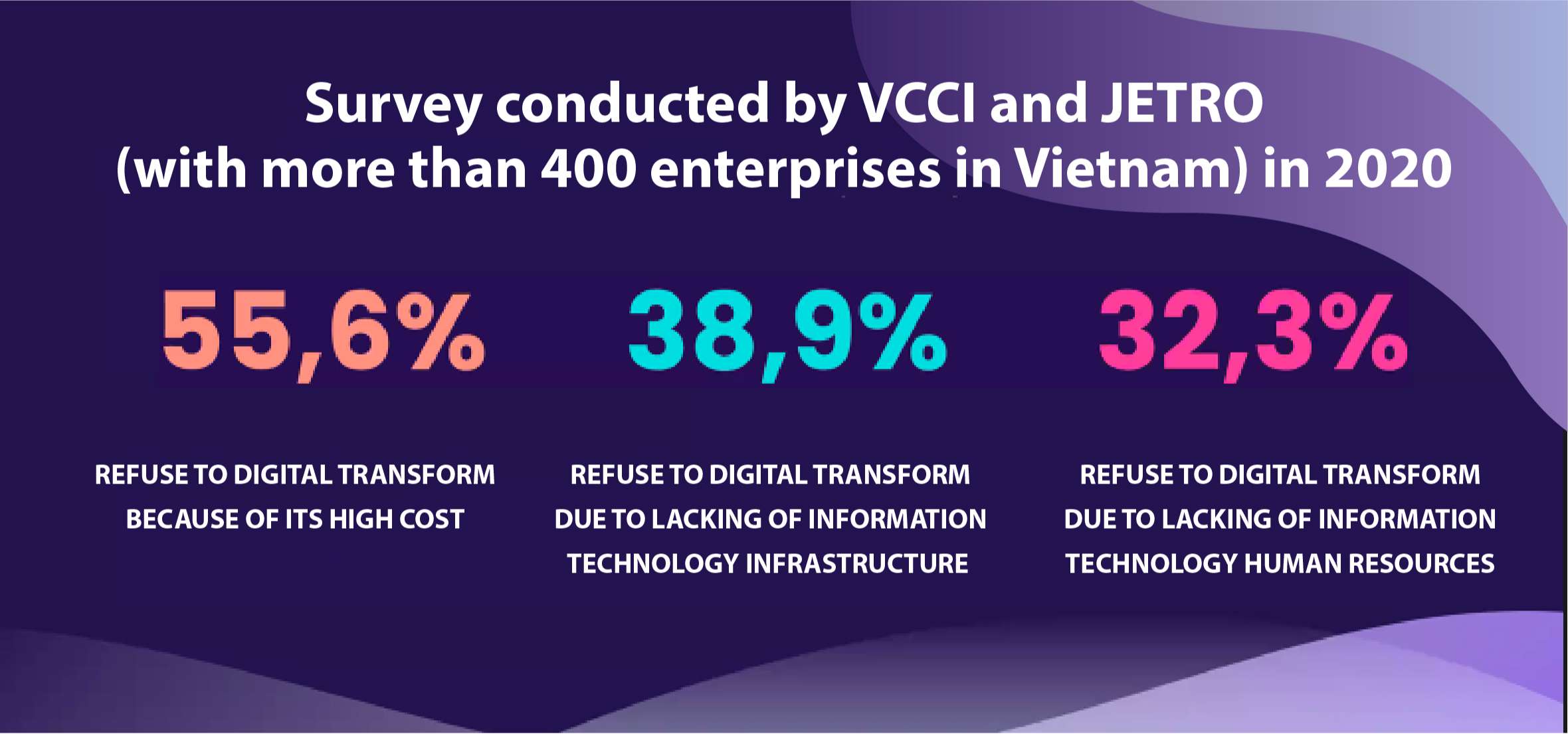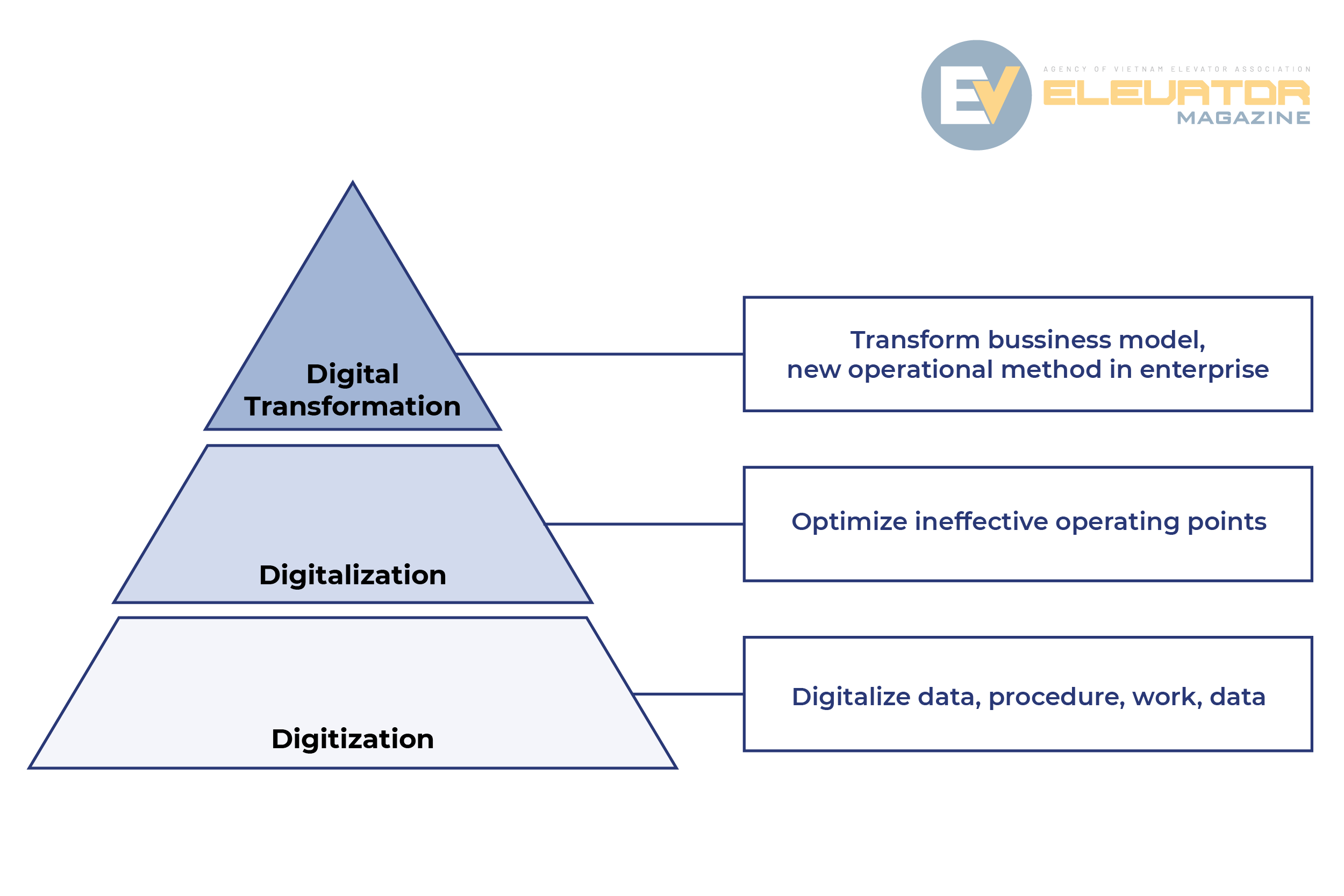EM – After more than a decade, the fourth industrial revolution has posed significant challenges for all countries and all fields: Digital Transformation or failure? The elevator industry in general and the elevator business community in particular are also facing this significant challenge. Will we succeed or become victim to the digital economy?
Kodak and the “boiled frog” syndrome
If in 1999, customers around the world had to pay up to 8 billion USD to get 21.6 billion photos, by 2013, users can show each other 21.9 billion photos on social networks for a price of 0 dong. The contrast of the two numbers above shows that the reason for Kodak’s disappearance is that they failed to see the changing market and did not digitize the film industry.
The reality shows that the 4th industrial revolution, more specifically Digital Transformation, is happening every hour, every minute and is an inevitable trend of the world economic flow. Kodak was too conservative, sleeping on victory, turning himself into a “frog” victim in the syndrome below.
If a frog is put directly into a pot of boiling water, it will jump right out. But if you put the frog in a pot of cold water, slowly heat it to a boil, the frog will not realize the danger is increasing and will die. This is the “boiled frog” syndrome.

Conservative thinking before the trend of Revolution 4.0 makes Kodak brand and revenue steer to the ground
Digital Transformation in Vietnam – The game has just begun
Lessons learned when the world implements Digital Transformation has given Vietnam profound experiences to avoid making mistakes and risks. However, in fact, research by RMIT University in Vietnam has shown that up to 80% of businesses are said to be unsuccessful in Digital Transformation due to human factors: In favor of technology but forgetting to build management capacity.
The digital economy poses a requirement for businesses in the elevator industry to quickly integrate into the big game: Digital Transformation. The Covid pandemic that broke out at the beginning of 2020 also pushed the elevator industry into difficulties during the past two years and it is not expected that by 2022 there will be no strong breakthrough. But in “Danger” there is “Opportunity” because it was during this time that many businesses restructured and reshaped their organizations and business models. A specific and most intuitive example is the conversion from the traditional way of working at the office to the form of working online via the internet. Enterprises are forced to digitize a lot of data and put them in the “cloud” for common use. Information technology application becomes an irreplaceable means. It is such simple things that have forced business leaders and employees to actively change their thinking and working methods to be more modern. The digital economy has made the line between upskilling to survive or to be eliminated become lighter.

Domestic enterprises are not interested in Digital Transformation due to many barriers
An enterprise in the elevator industry shared that in the two months of July and August, when Hanoi implemented social distancing, the business increased advertising campaigns by 40% compared to the previous time. Obviously, when “offline” customer touchpoints are limited, a strategy to increase customer reach in cyberspace is essential. At the same time, the active replacement of traditional payment methods such as cash, check, etc. with e-commerce, customer care – multi-channel complaint settlement, etc., has brought positive effects to the business. Digital Transformation has proven to be an inevitable trend.
Need to think more fully and open
According to FSI, one of the units with a lot of experience in Digital Transformation, many businesses have an incomplete or confused view. For example, there are new businesses that can digitize documents and papers, put data in the “cloud” while the operating model has not been innovated yet, but believe they have succeeded in Digital Transformation. In fact, they are just starting at the bottom or second step of this complex and laborious process.
A survey by the Vietnam Software and IT Services Association (VINASA) shows that: 69% of surveyed enterprises do not know which partner to choose to implement Digital Transformation, 72% do not know where to start, 92% don’t know how to transform digitally. This fact poses the problem of needing to think properly about Digital Transformation.

Basic Digital Transformation in enterprises must be done in stages from bottom to top
Digitization is a term used to describe the conversion of physical documents into digital format. That way, businesses allow digital content to be included in the organization’s workflow. For example, to automate processes or give people access to information. At this level, individual implementations, data can transfer the connection.
Exploiting digital opportunities (Digitalization) is considered a step forward of digitization. Digitalization, also known as “process digitization”, “organizational digitization”, is the degree to which digital technologies combine previously digitized data to optimize production and business activities.
Digital Transformation is the stage in which business and management systems are connected and synchronously integrated. Information shared across departments and in real time. At this stage, businesses begin to invest heavily in initiatives to create innovation and creativity, to create new and breakthrough values.
Digital Transformation will not have to stop the process, but must complete each step sequentially and be the culmination of this process. And in that process, there will be a requirement for self-standardization “offline” within the enterprise, indirectly improving capacity step by step to advance to Digital Transformation. When Digital Transformation is completed, the model and way the business operate will also change. Enterprises have completely participated in the flow of the Digital Economy with extremely open opportunities.
How will the elevator industry go digital?
Imagine this, your business has installed thousands of elevators all over the territory of the S-shaped strip of land, even in Hong Kong or some remote island country. When the customer elevator has any problem, the signal will be transferred to the information center located in Hanoi. It only takes one on-site engineer to handle a customer problem from thousands of kilometers away if it’s a software bug. Only the process of new mechanical maintenance and repair requires direct intervention from technicians located in each area. How many resources will businesses save, how will efficiency and service quality be if this level is achieved?
But to do so, nothing else is required, other than Digital Transformation. In which, technology selection and management capacity building must proceed in parallel.
There are three typical digital technologies driving Digital Transformation in the elevator industry: Internet of Things (IoT), Big Data and Artificial Intelligence (AI). Besides, Block Chain has been forecasted but as a future trend, we will not mention it here for the time being.
Internet of Things – IoT is a network that connects many devices through sensors, software and hardware technologies embedded in the device, specifically here an elevator. At that time, elevators, personal computers, mobile devices, building information systems or maintenance units… are all connected through the shared benefits of the Internet. Elevators have now become smarter.
Once there is IoT, it will generate a huge amount of data, extremely complex that people call Big Data. Big Data is the information asset of the industry and enterprise, which has a super large and diverse data volume, requiring new technology to process. Then, the information fields hidden deep in the data are exploited and optimized in the data processing process. Imagine when elevators have IoT, elevator information will always be updated 24/7 to provide problems that need to be solved such as error warnings or predictive maintenance plans. At that time, Artificial Intelligence (AI) will synthesize, analyze and understand the user’s behavior to make suggestions about the elevator’s operating decisions…
In fact, the boundaries between technology platforms are becoming increasingly blurred. Technologically Digital Transformation will require a blend of technologies to achieve the goal.

Digital Transformation starts with systematic thinking and long-term vision
While technology is the fundamental factor, the human factor is decisive for the success or failure of Digital Transformation. What if inadequate thinking about Digital Transformation comes from key positions in the industry and in the business? Culture Digital Transformation is not smooth from top to bottom? The ability to master technology is still unsatisfactory?
David Lang, a Digital Transformation expert of YellowBlocks, who has consulted for leading corporations in the US such as AT&T, Toyota, and Sony, shared: “The focus of Digital Transformation is not on smart technology, but lies in the transformational factor about people, thinking and culture of an enterprise or organization”.
I suddenly remembered the words of the Chairman of the Vietnam Elevator Association when he pondered: “Unify and standardize human resources in the elevator industry – Why not?”. This idea is a great suggestion for the elevator business community build capacity for industry personnel together, and is the basic foundation for Digital Transformation. This will create positive signals for the wave of Digital Transformation in the elevator community to become stronger.
Vietnam Elevator Association with the role of “midwife”
Currently, the elevator industry business community is also making efforts to conduct Digital Transformation. Businesses have a young workforce, early access to and connection to the Internet. This is the ideal condition to master technology, transfer scientific and technical progress and make Digital Transformation more favorable.
But besides that, small resources will make businesses “drowns” in the big game. This will also be a big challenge, requiring the unity and consensus of the business community in the industry. The role of “midwife” of the Vietnam Elevator Association will have to be promoted to the right capacity.
“We also know that many businesses in the industry are still struggling with Digital Transformation. To a certain extent, this is also the responsibility of the Vietnam Elevator Association when it comes to supporting its members. It is the approach to thinking, methods and building human capacity for appropriate Digital Transformation. Thereby promoting Vietnam’s elevator industry to develop sustainably. The General Secretary of the Association expressed goodwill.
Although the elevator industry is accounting for a modest proportion of GDP, the average growth rate of 5% per year has shown great potential. This young field will have more advantages for Digital Transformation than other fields
The problem is how do we do it./

The Vietnam Elevator Association is ready to support knowledge and technology transfer towards a sustainable development community
Thai Son
Designer: Trong Tan



